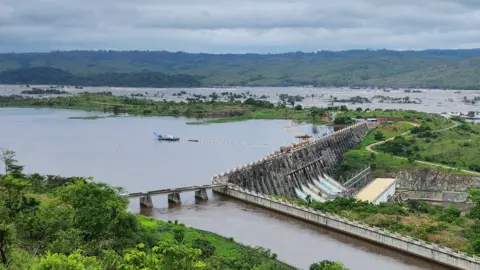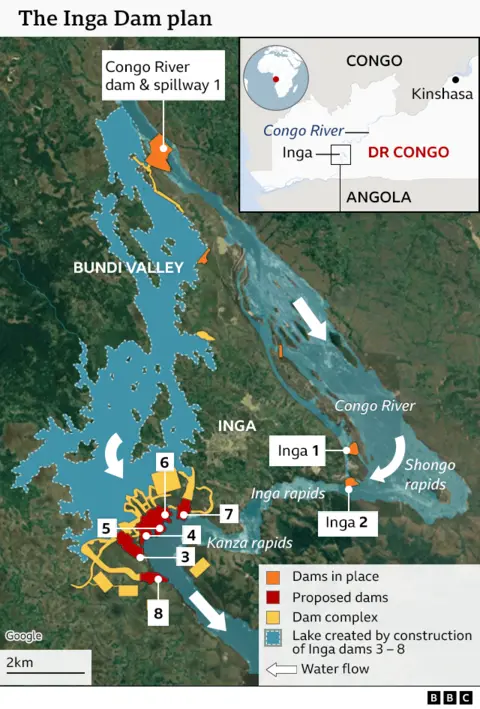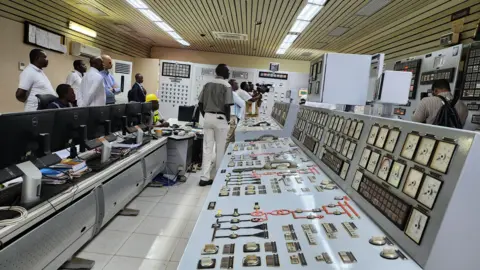Is the Democratic Republic of Congo’s plan to build the world’s largest hydroelectric dam still going ahead?
BBC news
 Mbeli Msochi
Mbeli MsochiFrom the Roaring Rapids Collection comes a great vision.
There are plans to build a spectacular, multibillion-dollar mega-dam on the Congo River—one that would generate enough renewable electricity to power large swaths of Africa.
The structure is called the Grand Inga Dam. Located in the Democratic Republic of Congo, it would have twice the capacity of China’s Three Gorges, making it the world’s largest hydroelectric power plant.
The Great Inga Dam has lured investors and developers, but decades after it was first dreamed up, the land reserved for its construction remains untouched.
When the government of the Democratic Republic of the Congo insists Critics of the plan, which is still in motion, point to long-term delays, DRC’s poor governance, and potential environmental damage.
There is also concern about the project’s rotating set of international partners. Just last week, the Chinese state-owned Three Gorges Corporation pulled out of the project, a source close to the partnership told the BBC.
And then there’s the eye-watering bill, said to be up to $80bn (£63bn) in the world’s poorest country.
But some believe that Nigerians hold Grand Inga on a different level than other major infrastructure projects. And although the construction has not started, there have been many meetings and discussions between interested parties in the past year.
The interest of the great Inga is certainly there. About 600 million people in sub-Saharan Africa do not have access to electricity, according to the International Energy Agency.
Attempts to solve this problem go back decades – in the early 2000s, the Democratic Republic of Congo and its neighbors – South Africa, Angola, Namibia and Botswana – dreamed of an interconnected electricity grid.
Realizing that the mighty waters had great hydropower potential, they saw the vast Congo River.
An international consortium known as Westcor wanted to duplicate the existing two dams on the river – Inga 1 and Inga 2.
The long-time leader of the Democratic Republic of Congo, Mobutu Sese Seko, oversaw their construction in the 1970s and 1980s, but by the end of the century both dams had collapsed due to lack of funds for maintenance.
Westcore eventually disbanded but Grand Inga’s dream endured. Inga 1 and 2 are now operating at around 80% of capacity and DRC plans to add six more dams along the river to replenish this production.
These additional dams are expected to generate up to 40,000 MW of electricity At any time – enough to move New York City for four days in the summer.
Through Inga, the Democratic Congo will play the role of “trigger of the African revolution… to stimulate the industrialization of Africa,” according to the country’s Grand Inga Project Development and Expansion Agency.
The agency was contacted for comment by the BBC for this article.
Inga 3 Although it was earlier estimated to be completed in 2018, construction has not even begun.
Lack of visible progress has stalled the project, but the message from the World Bank – the world’s leading development agency – is otherwise.

At the end of last year, the bank announced that it was in talks with the Congolese government about ending funding for Inga 3 in 2016.
The World Bank cited “strategic differences” but eight years later – and Felix Tshisekedi replacing Joseph Kabila as president of the Democratic Republic of Congo – has made a change.
I think it’s the first time I’ve ever felt more optimistic. I believe we can do it,” the World Bank’s Energy and Exports Director told a panel in South Africa last February.
This optimism seems to be felt elsewhere as well. A consortium of pan-African financial institutions, including the African Development Bank, has recently been working together to attract private investors to the project.
The Grand Inga is like a “snake – it’s up, it’s down, it’s visible, it’s invisible,” José Ángel González Taus, chairman of AEE Power, a Spanish-led company and partner in the project, told the BBC.
In November, Fabrice Lucinde, head of the Democratic Republic of Congo’s public electricity company Snel, said that if Inga 3 were to be commissioned in 2026, the two turbines should be operational by 2032. He said that the electricity produced by these turbines will cover the other costs of the plant. It has turbines.
Inga 3 is expected to generate 4,800MW of electricity on its own. South Africa, country Interrupted by regular power outagesThey have signed a memorandum of understanding to import more than half of this amount.
South African officials argue that Inga provides consistent and reliable power, but critics in the country say cheaper electricity can be found elsewhere.
A Nigerian company called Natural Oilfield Services has also reportedly signed up as a buyer. Like South Africa, Nigeria also suffers from severe electricity shortages.
Guinea and Angola are said to have expressed interest in the Great Inga Dam.
So why – after decades of discussion – have no new dams been built?
“It’s a project in the Democratic Republic of the Congo,” Mr. Tows said bluntly. “Although the project is one of the best in the world – it is not credible.”
The Democratic Republic of Congo has been plagued by corruption, lack of infrastructure and underdevelopment for decades. The conflict in the eastern part of the country has also made international news – even though Inga is thousands of kilometers away from the fighting.
“Who knows what will happen in the Congo in the next 30 years,” Mr. Tows said, adding that investors are also “frightened” by the fact that Grand Inga has not shown returns for decades.
Mr Tows – whose father worked as an engineer on Inga 1 in 1972 – also said the Congolese government’s lack of financial commitment had contributed to the delay.
And then there is the issue of funding. In September 2023, the president of the Democratic Republic of Congo told reporters that the country was “still having trouble raising investments for the dam.”
The recent withdrawal of China’s Three Gorges Corporation has exacerbated these problems. Three Gordes was the main partner, which brings money and knowledge to the complex project.
According to our BBC source, who asked not to be named, three Gorgos Gorgos have announced that they have pulled out of the competition because they are upset with the way President Tshisekidi of the Democratic Republic of Congo is handling the project.
Nothing has been officially confirmed about the release.
 Mbeli Msochi
Mbeli MsochiBut are these problems unique to the Great Inga Dam? Professor George Agdis, a hydropower expert at the UK’s Lancaster University, says it’s not true.
He said years of delays and multiple partner changes were “normal” for a major infrastructure project like the Inga Dam.
He points to the UK The Mersey Wave Project – If successful, this would be the world’s largest tidal barrier. The idea was first floated in 1984 and abandoned, only to be revived in the decades since.
“Does that mean we’re unstable here in the UK?” Mr. Agdidi asks. He described Inga’s project as “doable.”
Alexander Schwab, CEO of Austria-based Andritz, which has signed on to supply equipment for Inga 3, has a similar opinion.
Mr Schwab said Andritz had signed a memorandum of understanding with the Congolese authorities but no word on the project as of 2021.
The lack of communication seems largely unfazed by the fact that one of the three major infrastructure projects “stands still.”
For Mr. Schwab, Grand Inga is “one of the best mega-projects in the world.”
But despite its potential, there are deep concerns about the project’s environmental and social impact.
A common criticism is that the dam benefits South African users and DRC mining companies, not the Congolese people. 80% of the population has no access to electricity.
“Inga will not bring electricity to the people,” said Emmanuel Musuyu, head of the Congolese civil society coalition Corap. He alleged that most of the electricity was promised to South Africa and the mines.
In a recent report on Inga 3, DRC officials acknowledged that the dam “is not enough alone to solve DRC’s energy and development challenges” but could be a “trigger” for national change.
The World Bank said it was investigating how to support the government to ensure INGA “delivers broad-based benefits for energy supply”.
Environmental and rights groups are also worried about 37,000 Residents living in Inga area will be evicted without compensation. According to organizations such as International Rivers and Observatori del Deute en la Globalitzación, thousands of people were forcibly evicted from their homes and given no compensation during the construction of Inga I and II.
They also say that the first two dams have damaged the region’s biodiversity and more dams may follow suit.
“It will have a different effect on fish and all the animals in the water… When you change the flow of water in the rivers, we can see some species of fish disappear,” said Mr Musuyu.
2018 study He argued that several large hydropower projects in Europe and the US were dangerous to the environment..
Officials in the Democratic Republic of Congo have acknowledged that people will be displaced by Inga Sot, but have promised that residents will be resettled in areas with basic services and that “fair compensation” will be paid.
They also realized the danger in the local area and said that an assessment aimed at reducing this impact will be completed in the next two years. However, according to a BBC source close to the project, the authorities have not yet raised enough funds for these studies.
If Grand Inga is facing the challenges of major infrastructure projects, the World Bank may still be optimistic.
But the dam is a complex engineering project – one that requires many stakeholders to work in harmony.
When the World Bank returned only for the three governors to leave, D.R.
And despite the Democratic Republic of Congo’s interest, construction cannot begin until funding is secured.
So now, this project that has the potential to change the lives of millions of people in Africa seems to be going ahead – a big vision.
You may want to:
 Getty Images/BBC
Getty Images/BBC

